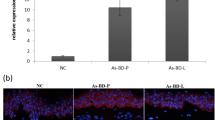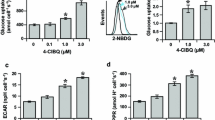Abstract
Vanadium is a metal widely distributed in the environment. Although vanadate-containing compounds exert potent toxic effects on a wide variety of biological systems, the mechanisms by which vanadate mediates adverse effects are not well understood. The present study investigated the vanadate-induced phosphorylation of Akt and p70S6K, two kinases known to be vital for cell survival, growth, transformation, and transition of the cell cycle in mammals. Exposure of mouse epidermal JB6 cells to vanadium led to phosphorylation of Akt and p70S6K in a time- and dose-dependent manner. Vanadium exposure also caused translocation of atypical isoforms of PKC (λ, ζ) from the cytosol to the membrane, but had no effect on PKCα translocation, suggesting that the atypical PKCs (aPKC) were specifically involved in vanadium-induced cellular response. Importantly, overexpression of a dominant negative mutant PKCλ blocked Akt phosphorylation at Ser473 and Thr308, whereas it did not inhibit p70S6k phosphorylation at Thr389 and Thr421/Ser424, suggesting that aPKC activation is specifically involved in vanadium-induced activation of Akt, but not in activation of p70S6k. Furthermore, vanadium-induced p70S6k phosphorylation at Thr389 and Thr421/Ser424 and Akt phosphorylation at Thr308 occurred through a PI-3K-dependent pathway because a PI-3K dominant negative mutant inhibited induction as compared with vector control cells. These results indicate that there was a differential role of aPKC in vanadate-induced phosphorylation of Akt and p70S6k, suggesting that signal transduction pathways leading to the activation of Akt and p70S6k were different.
Similar content being viewed by others
References
Nriagu JO, Pacyna JM: Quantitative assessment of worldwide contamination of air, water and by trace metals. Nature 333: 134–139, 1988
Ding M, Li JJ, Leonard SS, Ye JP, Shi X, Colburn NH, Castranova V, Vallyathan V: Vanadate-induced activation of activator protein-1: Role of reactive oxygen species. Carcinogenesis 20: 663–668, 1999
Huang C, Chen N, Ma WY, Dong Z: Vanadium induces AP-1-and NF-κB-dependent transcription activity. Int J Oncol 13: 711–715, 1998
Cohen MD, Klein CB, Costa M: Forward mutations and DNA-protein crosslinks induced by ammonium metavanadate in cultured mammalian cells. Mutat Res 269: 141–148, 1992
Sheu CW, Rodriguez I, Lee JK: Proliferation and morphological transformation of BALB/3T3 cells by a prolonged treatment with sodium orthovanadate. Food Chem Toxicol 30: 307–311, 1992
Susa M, Olivier AR, Fabbro D, Thomas G: EGF induces biphasic S6 kinase activation: Late phase is protein kinase C-dependent and contributes to mitogenicity. Cell 57: 817–824, 1989
Proud CG: p70 S6 kinase: An enigma with variations. Trends Biochem Sci 21: 181–185, 1996
Reinhard C, Thomas G, Kozma SC: A single gene encodes two isoforms of the p70 S6 kinase: Activation upon mitogenic stimulation. Proc Natl Acad Sci USA 89: 4052–4056, 1992
Toker A: Protein kinases as mediators of phosphoinositide 3-kinase signaling. Mol Pharmacol 57: 652–658, 2000
Shepherd PR, Withers DJ, Siddle K: Phosphoinositide 3-kinase: The key switch mechanism in insulin signaling. Biochem J 333: 471–490, 1998
Pearson RB, Dennis PB, Han JW, Williamson NA, Kozma SC, Wettenhall RE, Thomas G: The principal target of rapamycin-induced p70s6k inactivation is a novel phosphorylation site within a conserved hydrophobic domain. Embo J 14: 5279–5287, 1995
Han JW, Pearson RB, Dennis PB, Thomas G: Rapamycin, wortmannin, and the methylxanthine SQ20006 inactivate p70s6k by inducing dephosphorylation of the same subset of sites. J Biol Chem 270: 21396–21403, 1995
Ferrari S, Bannwarth W, Morley SJ, Totty NF, Thomas G: Activation of p70s6k is associated with phosphorylation of four clustered sites displaying Ser/Thr-Pro motifs. Proc Natl Acad Sci USA 89: 7282–7286, 1992
Staal SP: Molecular cloning of the Akt oncogene and its human homologues AKT1 AKT2: Amplification of AKT1 in a primary human gastric adenocarcinoma. Proc Natl Acad Sci USA 84: 5034–5037, 1987
Bellacosa A, Testa JR, Staal SP, Tsichlis PN: A retroviral oncogene, Akt, encoding a serine-threonine kinase an SH2-like region. Science 254: 274–277, 1991
Bellacosa A, Franke TF, Gonzalez-Portal ME, Datta K, Taguchi T, Gardner J, Cheng JQ, Testa JR, Tsichlis PN: Structure, expression and chromosomal mapping of c-akt: Relationship v-Akt and its implications. Oncogene 8: 745–754, 1993
Datta SR, Brunet A, Greenberg ME: Cellular survival: A play in three Akts. Genes Dev 13: 2905–2927, 1999
Mayer BJ, Ren R, Clark KL, Baltimore D: A putative modular domain present in diverse signaling proteins. Cell 73: 629–630, 1993
Musacchio A, Gibson T, Rice P, Thompson J, Saraste M: The PH domain: A common piece in the structural patchwork of proteins. Trends Biochem Sci 18: 343–348, 1993
Burgering BM, Coffer PJ: Protein kinase B (c-Akt) in phosphatidylinositol-3-OH kinase signal transduction. Nature 376: 599–602, 1995
Franke TF, Yang SI, Chan TO, Datta K, Kazlauskas A, Morrison DK, Kaplan DR, Tsichlis PN: The protein kinase encoded by the Akt proto-oncogene is a target of PDGF-activated phosphatidylinositol 3-kinase. Cell 81: 727–736, 1995
Alessi DR, Andjelkovic M, Caudwell B, Cron P, Morrice N, Cohen P, Hemmings B: A mechanism of activation of protein kinase B by insulin and IGF-1. Embo J 15: 6541–6551, 1996
Pandey SK, Theberge JF, Bernier M, Srivastava AK: Phosphatidylinositol 3-kinase requirement in activation of the ras/C-raf-1/MEK/ERK and p70(s6k) signaling cascade by the agent vanadyl sulfate. Biochemistry 38: 14667–14675, 1999
Huang C, Ma WY, Dong Z: Requirement for phosphatidylinositol 3-kinase in epidermal growth factor-induced AP-1 transactivation and transformation in JB6 P+ cells. Mol Cell Biol 16: 6427–6435, 1996
Huang C, Ma W, Bowden GT, Dong Z: Ultraviolet B-induced activated protein-1 activation does not require epidermal growth factor receptor but is blocked by a dominant negative PKClambda/iota. J Biol Chem 271: 31262–31268, 1996
Huang C, Li J, Chen N, Ma W, Bowden GT, Dong Z: Inhibition of atypical PKC blocks ultraviolet-induced AP-1 activation specifically inhibiting ERKs activation. Mol Carcinog 27: 65–75, 2000
Newton AC: Protein kinase C. Seeing two domains. Curr Biol 5: 973–976, 1995
Huang C, Schmid PC, Ma WY, Schmid HH, Dong Z: Phosphatidylinositol-3 kinase is necessary for 12-O-tetradecanoylphorbol-13-acetate-induced cell transformation and activated protein 1 activation. J Biol Chem 272: 4187–4194, 1997
Jeno P, Ballou LM, Novak-Hofer I, Thomas G: Identification and characterization of a mitogen-activated S6 kinase. Proc Natl Acad Sci USA 85: 406–410, 1988
Klippel A, Reinhard C, Kavanaugh WM, Apell G, Escobedo MA, Williams LT: Membrane localization of phosphatidylinositol 3-kinase is sufficient to activate multiple signal-transducing kinase pathways. Mol Cell Biol 16: 4117–4127, 1996
Weng QP, Andrabi K, Klippel A, Kozlowski MT, Williams LT, Avruch J: Phosphatidylinositol 3-kinase signals activation of p70 S6 kinase in situ through site-specific p70 phosphorylation. Proc Natl Acad Sci USA 92: 5744–5748, 1995
Moule SK, Edgell NJ, Welsh GI, Diggle TA, Foulstone EJ, Heesom KJ, Proud CG, Denton RM: Multiple signaling pathways involved in the stimulation of fatty acid glycogen synthesis by insulin in rat epididymal fat cells. Biochem J 311: 595–601, 1995
Pullen N, Dennis PB, Andjelkovic M, Dufner A, Kozma SC, Hemmings BA, Thomas G: Phosphorylation and activation of p70s6k by PDK1. Science 279: 707–710, 1998
Aoki M, Batista O, Bellacosa A, Tsichlis P, Vogt PK: The akt kinase: Molecular determinants of oncogenicity. Proc Natl Acad Sci USA 95: 14950–14955, 1998
Chang HW, Aoki M, Fruman D, Auger KR, Bellacosa A, Tsichlis PN, Cantley LC, Roberts TM, Vogt PK: Transformation of chicken cells by the gene encoding the catalytic of PI 3-kinase. Science 276: 1848–1850, 1997
Skorski T, Bellacosa A, Nieborowska-Skorska M, Majewski M, Martinez R, Choi JK, Trotta R, Wlodarski P, Perrotti D, Chan TO, Wasik MA, Tsichlis PN, Calabretta B: Transformation of hematopoietic cells by BCR/ABL requires activation PI-3k/Akt-dependent pathway. Embo J 16: 6151–6161, 1997
Bellacosa A, de Feo D, Godwin AK, Bell DW, Cheng JQ, Altomare DA, Wan M, Dubeau L, Scambia G, Masciullo V: Molecular alterations of the AKT2 oncogene in ovarian and breast carcinomas. Int J Cancer 64: 280–285, 1995
Cheng JQ, Ruggeri B, Klein WM, Sonoda G, Altomare DA, Watson DK, Testa JR: Amplification of AKT2 in human pancreatic cells and inhibition of AKT2 expression and tumorigenicity by antisense RNA. Proc Natl Acad Sci USA 93: 3636–3641, 1996
James SR, Downes CP, Gigg R, Grove SJ, Holmes AB, Alessi DR: Specific binding of the Akt-1 protein kinase to phosphatidylinositol 3,4,5-trisphosphate without subsequent activation. Biochem J 315: 709–713, 1996
Franke TF, Kaplan DR, Cantley LC, Toker A: Direct regulation of the Akt proto-oncogene product by phosphatidylinositol-3,4-bisphosphate. Science 275: 665–668, 1997
Frech M, Andjelkovic M, Ingley E, Reddy KK, Falck JR, Hemmings BA: High affinity binding of inositol phosphates and phosphoinositides to pleckstrin homology domain of RAC/protein kinase B and their influence kinase activity. J Biol Chem 272: 8474–8481, 1997
Klippel A, Kavanaugh WM, Pot D, Williams LT: A specific product of phosphatidylinositol 3-kinase directly activates protein kinase Akt through its pleckstrin homology domain. Mol Cell Biol 17: 338–344, 1997
Sable CL, Filippa N, Hemmings B, Van Obberghen E: cAMP stimulates protein kinase B in a Wortmannin-insensitive manner. FEBS Lett 409: 253–257, 1997
Filippa N, Sable CL, Filloux C, Hemmings B, Van Obberghen E: Mechanism of protein kinase B activation by cyclic AMP-dependent kinase. Mol Cell Biol 19: 4989–5000, 1999
Nakanishi H, Brewer KA, Exton JH: Activation of the zeta isozyme of protein kinase C by phosphatidylinositol 3,4,5-trisphosphate. J Biol Chem 268: 13–16, 1993
Standaert ML, Galloway L, Karnam P, Bandyopadhyay G, Moscat J, Farese RV: Protein kinase C-zeta as a downstream effector of phosphatidylinositol 3-kinase during insulin stimulation in rat adipocytes. Potential role in glucose transport. J Biol Chem 272: 30075–30082, 1997
Romanelli A, Martin KA, Toker A, Blenis J: p70 S6 kinase is regulated by protein kinase Czeta and participates in a phosphoinositide 3-kinase-regulated signaling complex. Mol Cell Biol 19: 2921–2928, 1999
Huang C, Zhang Z, Ding M, Li J, Ye J, Leonard SS, Shen HM, Butterworth L, Lu Y, Costa M, Rojanasakul Y, Castranova V, Vallyathan V, Shi X: Vanadate induces p53 transactivation through hydrogen peroxide and causes apoptosis. J Biol Chem 275: 32516–23252, 2000
Author information
Authors and Affiliations
Rights and permissions
About this article
Cite this article
Li, J., Dokka, S., Wang, L. et al. Activation of a PKC is required for vanadate-induced phosphorylation of protein kinase B (Akt), but not p70S6k in mouse epidermal JB6 cells. Mol Cell Biochem 255, 217–225 (2004). https://doi.org/10.1023/B:MCBI.0000007277.90298.24
Issue Date:
DOI: https://doi.org/10.1023/B:MCBI.0000007277.90298.24




